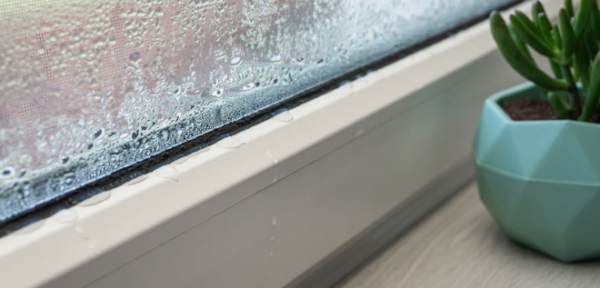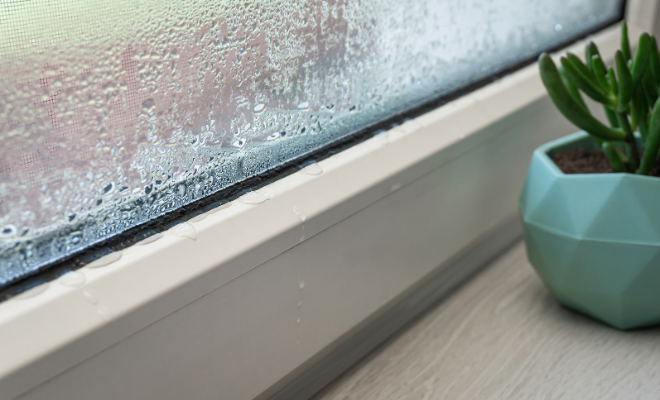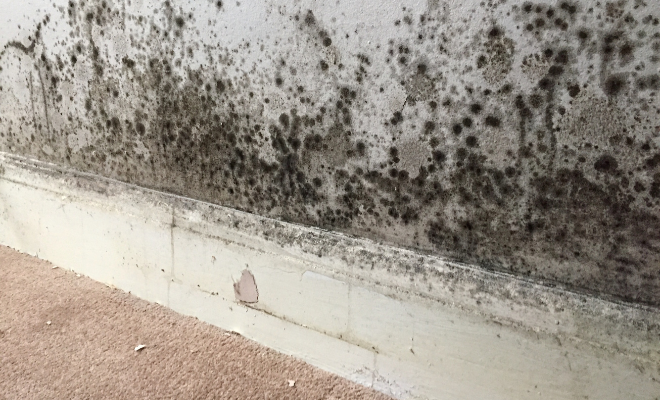Understanding Condensation: What Is It and Why Does It Matter?.

The first thing to understand when considering condensation in homes (and indeed damp in general) is that water, in all its forms (as a liquid, as water vapour and sometimes as a solid) is all around us. Life on Earth could not exist without water. Humans are approximately 60-70% water and cannot survive for more than about 3 days without water.
When we talk about condensation, we are referring to the water that collects on a surface when water vapour in the air changes from a gas to a liquid. This process happens because air can hold a certain amount of water vapour depending on its temperature – the warmer the air, the more water vapour it can hold.
Condensation occurs when the air can no longer hold water vapour, which is determined by the balance between air temperature and the maximum amount of moisture it can retain. If this equilibrium is disrupted – either by an increase in moisture content or a decrease in temperature – the air reaches its dew point, causing the excess water vapour to condense into liquid on cooler surfaces.

As a result, we can sometime see the excess moisture in liquid form when the water settles onto a cooler surface which has caused the air to cool. This is why we often see condensation forming on cold glass in a warm room or on walls in areas with high humidity, such as kitchens and bathrooms.
So, it is not the water itself that is the problem. It is when water is in the wrong form, in the wrong place and in the wrong amount that it can become problematic.
Damp Isn’t Just About Condensation – What Other Ways Does Damp Get In?
Water can enter a home in several ways, both from within and outside the building.
Everyday activities in the home such as cooking, bathing, and drying clothes release large amounts of water vapour into the air. However, water can also get in through faulty plumbing or drainage, via leaking roofs, blocked or broken gutters and downpipes, poorly specified details around roofs and walls, from groundwater which moves up through porous materials like brick or plaster, poorly maintained pointing, cracked render or damaged window seals.
It is essential to remember is that once a building element becomes damp, it tends to remain colder than surrounding areas, which then increases the chances of condensation forming on its surface. This creates a cycle where damp areas not only result from water ingress but also then encourage further moisture problems through condensation, worsening the overall damp conditions within a property. Condensation is not the problem – rather it is the symptom of an underlying issue.
How Condensation Leads to Bigger Problems
Mould is a microscopic fungus that thrives in moist environments.
While condensation is normal, excessive moisture without proper ventilation creates an ideal environment for mould to grow. The health risks can be significant. Mould spores can cause respiratory issues, particularly for children, the elderly, and those with existing conditions. As seen in the case of Awaab Ishak, prolonged exposure can have devastating consequences.

Beyond health risks, mould damages interiors such as carpets, furniture and decorative finishes, while prolonged exposure to moisture can have serious consequences for the building fabric. Persistent dampness can weaken plaster, cause paint to peel and encourage rot in timber elements, compromising skirting boards, floor joists and even structural beams. If the underlying cause of moisture is not identified and effectively addressed through appropriate repairs, such as fixing leaks, improving or repairing drainage, or improving ventilation, the damage can escalate. Over time, untreated damp can lead to timber decay, corrosion of metal components and deterioration of masonry, resulting in significant structural issues. These problems not only reduce the lifespan of the building but can also lead to extensive and costly repairs that could have been prevented with timely intervention.
Managing Condensation
Each case of condensation requires tailored solutions, but key strategies include:
- Temperature control: Keeping indoor temperatures stable helps prevent condensation. Public Health England recommend maintaining a minimum indoor temperature of around 18°C (essential for the elderly or people with health conditions) with slightly higher temperatures offering added benefits. Overnight, 18°C remains advisable for vulnerable groups.
- Moisture reduction: Simple changes can help, such as using a squeegee to remove excess water after bathing, cooking with lids on pans and drying clothes away from radiators.
- Ventilation improvement:Simply opening windows isn’t enough – new and replacement windows must have trickle vents (mandatory from June 2022 in England and November 2023 in Wales) which should be kept open, and extractor fans in kitchens and bathrooms should be maintained and must vent outside, not into walls or roof voids. Continuous airflow should be promoted by keeping internal door vents or undercuts clear, avoiding pushing furniture directly against walls and ensuring air bricks and loft ventilation remain unobstructed.
- Correctly identifying and managing essential repairs: So often, condensation is the evidence of an underlying problem. It is, therefore, essential for the problem to be identified quickly and correctly and for correct repairs to be undertaken. Here at Sava, we run a webinar where we talk about a case study when failure to correctly identify a leaking toilet led to more than £12,000 in repairs. In that case, water from the leak also got into the electrical system, putting the occupants’ safety at risk.
Understanding damp and condensation goes far beyond simple fixes – it requires a deep knowledge of how buildings function and how we live in them. This article only scratches the surface of a complex issue that affects both property condition and occupant health.
For housing providers looking to deepen their expertise, we offer bespoke training on damp as well as virtual classroom events and specialist qualifications covering damp and condensation, and related topics. Get in touch today to learn more about how we can support your team in managing and preventing these issues effectively.
Contact a Course Advisor
Tel: 01908 442158
Email: hello@sava.co.uk
Browse qualifications: https://sava.co.uk/qualifications